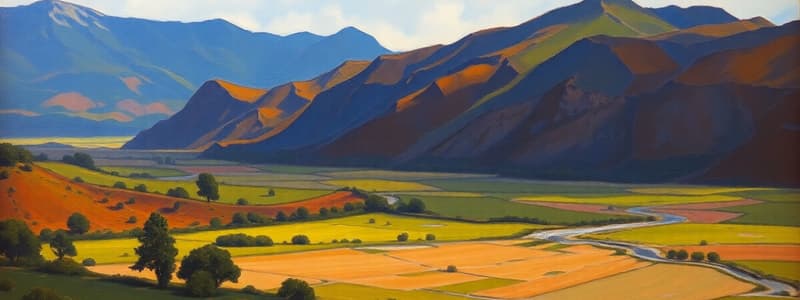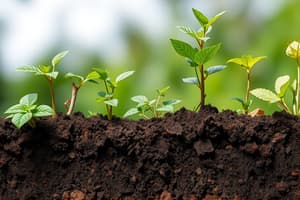Podcast
Questions and Answers
What is a major consequence of poor forestry practices such as logging and burning?
What is a major consequence of poor forestry practices such as logging and burning?
- Enhanced erosion control
- Reduced organic material (correct)
- Improved soil quality
- Increased biodiversity in the area
Which practice can contribute to soil conservation in agriculture?
Which practice can contribute to soil conservation in agriculture?
- Continuous grazing
- Maintaining hedgerows (correct)
- Overirrigating crops
- Using excessive fertilizers
How does urbanization impact land use and management practices?
How does urbanization impact land use and management practices?
- It decreases the need for reclamation programs
- It increases the reliance on brownfield reclamation (correct)
- It leads to more agricultural land creation
- It enhances natural landscapes without reclamation
What is a consequence of overgrazing by livestock?
What is a consequence of overgrazing by livestock?
Which method is effective in reducing soil erosion on steep slopes?
Which method is effective in reducing soil erosion on steep slopes?
What sustainable practice can improve land after mining activities?
What sustainable practice can improve land after mining activities?
What has been the global annual rate of deforestation caused by human activity?
What has been the global annual rate of deforestation caused by human activity?
What is one way to enhance soil fertility in sustainable agriculture?
What is one way to enhance soil fertility in sustainable agriculture?
Which factor is most crucial for plant growth in topsoil?
Which factor is most crucial for plant growth in topsoil?
How does erosion impact topsoil quality?
How does erosion impact topsoil quality?
What is the process that involves the buildup of salts in the soil, affecting plant growth?
What is the process that involves the buildup of salts in the soil, affecting plant growth?
Which human action can result in soil degradation?
Which human action can result in soil degradation?
How long does it take approximately to produce an inch of topsoil?
How long does it take approximately to produce an inch of topsoil?
Which of the following best describes 'leaching' in the context of soil?
Which of the following best describes 'leaching' in the context of soil?
What is meant by the term 'tilth' in relation to soil?
What is meant by the term 'tilth' in relation to soil?
Which of the following practices can help in rehabilitating degraded landscapes?
Which of the following practices can help in rehabilitating degraded landscapes?
What is one benefit of sustainable building practices?
What is one benefit of sustainable building practices?
Which statement accurately reflects the impact of urban planning on community practices?
Which statement accurately reflects the impact of urban planning on community practices?
How can the negative impact of urbanization on land be mitigated?
How can the negative impact of urbanization on land be mitigated?
Which farming practice enhances soil fertility rather than degrading it?
Which farming practice enhances soil fertility rather than degrading it?
What characterizes the O horizon in soil formation?
What characterizes the O horizon in soil formation?
What is a primary purpose of terracing in agriculture?
What is a primary purpose of terracing in agriculture?
Which of the following practices can contribute to soil erosion?
Which of the following practices can contribute to soil erosion?
How does rainwater infiltration benefit land use?
How does rainwater infiltration benefit land use?
Flashcards
Soil Erosion
Soil Erosion
The process of topsoil being removed by wind and water.
Desertification
Desertification
Land degradation in drylands, often caused by overgrazing.
Sustainable Agriculture
Sustainable Agriculture
Farming methods that protect and improve soil quality over time.
Terracing
Terracing
Signup and view all the flashcards
Brownfields
Brownfields
Signup and view all the flashcards
Deforestation
Deforestation
Signup and view all the flashcards
Sustainable Forestry
Sustainable Forestry
Signup and view all the flashcards
Reclaimed Mine Sites
Reclaimed Mine Sites
Signup and view all the flashcards
Topsoil
Topsoil
Signup and view all the flashcards
Tilth
Tilth
Signup and view all the flashcards
Water Retention
Water Retention
Signup and view all the flashcards
Salinization
Salinization
Signup and view all the flashcards
Leaching
Leaching
Signup and view all the flashcards
Soil Degradation
Soil Degradation
Signup and view all the flashcards
Rehabilitation
Rehabilitation
Signup and view all the flashcards
Rain Gardens
Rain Gardens
Signup and view all the flashcards
Walkable Streets
Walkable Streets
Signup and view all the flashcards
Sustainable Urban Planning
Sustainable Urban Planning
Signup and view all the flashcards
Land Use Impact
Land Use Impact
Signup and view all the flashcards
Regenerative Agriculture
Regenerative Agriculture
Signup and view all the flashcards
O Horizon
O Horizon
Signup and view all the flashcards
Soil Conservation Techniques
Soil Conservation Techniques
Signup and view all the flashcards
Study Notes
Chapter 9: Land: How Does It Shape Us?
- This chapter explores how landforms are created and how human activities impact land.
- Earth's surface is dynamic, with forces shaping the ground.
- Topsoil and beach erosion are gradual changes in Earth's surface.
- Climate change contributes to sea level rise and accelerating erosion.
- Soil is a complex mixture of weathered rock, minerals, dead organic matter, and organisms.
- Soil is Earth's skin, but is much thinner than its overall size.
- Soil formation is through processes at Earth's surface where the lithosphere (rocks) and biosphere (life) interact, breaking down rock into particles.
- Air spaces in soil allow water infiltration, promoting aeration.
- Smaller soil particles influence infiltration and nutrient retention.
- Soil texture affects plant growth.
- Soil horizons are layers in soil.
- Soil profiles are cutaway views of soil horizons.
- Soil profiles are typically less than 3 feet deep.
Soil Horizons
- Soil horizons include O, A, B, and C.
- Topsoil (O and A horizons) has complex mixtures of material, including organic matter from living things.
- The O horizon consists of fallen leaves and organic matter (detritus).
- The A horizon is a mix of mineral fragments and organic matter.
- Water infiltrates through the A horizon.
- The B horizon (subsoil) is mainly mineral matter.
- The C horizon consists of weathered parent material (rock or sediment).
What Makes Soil Alive?
- Soil contains diverse life forms, including animals, microorganisms, insects, and worms.
- Nematode worms in soil's upper levels (A horizon) are incredibly numerous (up to 100,000 per cup of soil).
- Nematode worms feed on bacteria and fungi, producing nutrient-rich excrement.
- Earthworms burrow through soil, mixing soil and organic matter, resulting in castings (excrement).
- Soil microorganisms (bacteria and fungi) decompose organic matter.
- Microorganisms return vital nutrients and CO2 to the soil.
- Soil contains significant microorganisms (over 100,000 per cup).
Organic Matter and Soil Structure
- Complex organic compounds in soil are resistant to breakdown, creating humus (dark, sticky organic material).
- Humus enhances water and nutrient retention.
Soil Classification and Factors Affecting Soil Formation
- Biomes are linked to soil orders.
- Specific soil types exist in different regions like deserts.
Topsoil and Plant Growth
- A delicate balance of water, pore space, nutrients, and root space is essential for plant growth.
- Tilth refers to soil properties that facilitate plant growth.
- Topsoil thickens when forming faster than eroding.
Water in Topsoil
- Plants consume water, transporting it from roots to leaves (photosynthesis).
- Water also carries away nutrients (leaching) to deeper layers.
- Salinization (salt build-up) can inhibit plant growth.
Agriculture and Grazing
- Farming often accelerates soil erosion and degrades soil fertility.
- Tillage, overusing fertilizers/pesticides/herbicides, overgrazing, and overirrigation negatively impact soil.
- Sustainable practices enhance soil production and quality (like terracing, cover crops, rotational grazing).
The Erosion of Civilizations
- Plowing can expose soil to erosion.
- Sustainable farming was limited to flat areas like floodplains in ancient times.
Mining
- Mining, although not typically sustainable, can be rehabilitated with practices like importing topsoil to restore degraded landscapes.
- Creating mines in reclaimed areas can help restore biodiversity and create environmental learning environments.
Forestry
- Deforestation (logging/burning) occurs at a global pace of 13 million hectares per year.
- Cutting trees causes soil erosion. Soil binding ability is reduced.
- Steep slopes and excessive harvesting can cause landslides.
- Sustainable forest management can reduce impacts like soil loss.
Urbanization
- Reclamation programs for contaminated sites (brownfields) aim to restore degraded urban areas.
- Sustainable urban design can improve water management (rain gardens) for increased infiltration.
Take-Home Message (Chapter 9)
- Humans' land use (farming, grazing, mining, forestry, urban development) can substantially impact land.
- Regenerative agricultural practices can enhance soil fertility.
- Mining sites can be reclaimed.
- Urban areas can be made more environmentally friendly by using sustainable landscaping and site rehabilitation.
Studying That Suits You
Use AI to generate personalized quizzes and flashcards to suit your learning preferences.




